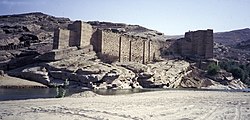
Back معبد أوام Arabic معبد اوام ARZ Temple d'Awwam Catalan Awwam German Mahram Bilqis Spanish Temple d'Awām French מקדש אוואם HE 마흐람 빌키스 Korean Marã Bilquis Portuguese Awwams tempel Swedish
معبد أوام | |
 Mahram Bilqis or Awam Temple in 2017 in Marib, Yemen | |
| Location | Awwam, Marib Governorate, Yemen |
|---|---|
| Coordinates | 15°24′15″N 45°21′21″E / 15.4042°N 45.3557°E |
| History | |
| Builder | Sabaeans |
| Founded | 1500–1200 BCE[1] |
| Periods | Ancient Yemen |
| Satellite of | Almaqah |
| Site notes | |
| Part of | Landmarks of the Ancient Kingdom of Saba, Marib |
| Criteria | Cultural: (iii), (iv) |
| Reference | 1700 |
| Inscription | 2023 (45th Session) |
| Endangered | 2023–... |
| Part of a series on the |
| History of Yemen |
|---|
|
|
The Temple of Awwam (Arabic: معبد أوام, Sabaean: 𐩱𐩥𐩣), commonly known as Mahram Bilqis (Arabic: محرم بلقيس, romanized: Mḥrm blqīs, lit. 'Sanctuary of the Queen of Sheba') by locals,[2] was the main Sabaean temple dedicated to their national god, Almaqah (frequently called "Lord of ʾAwwām"[3]), and it is also the largest known temple complex in South Arabia,[2] located near Marib in what is now Yemen. The temple is situated 7 kilometres (4.3 mi) southeast of ancient Marib, and was built in the outskirts of the city. Although usually major Sabaean sanctuaries are located outside urban centers, its placement was probably for reasons of religious privacy, and to facilitate the conduct of rituals by arriving pilgrims from remote areas of Sabaean territories.[4] Nearly a thousand inscriptions have been discovered from the Temple, comprising the single most important collection of Ancient South Arabian inscriptions[5] that provide the foundation for reconstructing an outline of the political history of Yemen in its first three centuries of the Christian era.[2]
The temple was in operation from the beginning of the 1st millennium BC until the 4th century AD.[5] Pilgrim rites began at the Harunum Temple, before moving to the Awwam Temple through a processional road connecting the two temples.[6]
In 2023, along with other landmarks of the ancient Kingdom of Saba, Awam Temple was added to the UNESCO World Heritage List.[7]
- ^ Zaid & Maraqten 2008, p. 228–240.
- ^ a b c Nebes 2023, p. 318.
- ^ A. V. Korotaev (1996). Pre-Islamic Yemen: Socio-political Organization of the Sabaean Cultural Area in the 2nd and 3rd Centuries AD. Otto Harrassowitz Verlag. p. 82. ISBN 978-3-447-03679-5.
- ^ Robin, 1996
- ^ a b Maraqten 2015, p. 107.
- ^ Maraqten 2021.
- ^ "Landmarks of Ancient Kingdom of Saba added to UNESCO's World Heritage List". Marib Governorate. 25 January 2023. Retrieved 26 March 2023.




